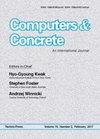A proposal for an approach for meso scale modeling for concrete based on rigid body spring model
IF 3.3
4区 工程技术
Q2 COMPUTER SCIENCE, INTERDISCIPLINARY APPLICATIONS
引用次数: 0
Abstract
Existing meso-scale models of concrete need to refine the mesh grids of aggregate and cement mortar, which may greatly reduce the computational efficiency. To overcome this problem, a novel meso-scale modeling strategy, which is based on rigid body spring method and Voronoi diagram, is proposed in this study to establish the meso-scale model of concrete. Firstly, establish numerical aggregate models according to user-defined programs. Circle aggregates are adopted due to their high efficiency in generation and packing process, and the grading of aggregate are determined according to the distribution curve proposed by Full and Thompson; Secondly, extract the centroids of aggregates, and then develop the Voronoi diagram in which aggregate centroids are defined as initial scatters; Finally, establish the rigid body spring model for concrete based on the Voronoi diagram. Aggregates are represented by rigid blocks, and assumed to be unbreakable. Cement mortar is concentrated into the interface between adjacent blocks and represented by two uniform springs. The number of grids is consistent with that of aggregates in specimens, and no mesh-refinement of aggregates and cement mortar is required. The accuracy and efficiency of the proposed modeling strategy are firstly identified by comparing the numerical results with the experimental ones, and then the applicability of the proposed strategy with different volume percentage occupied by aggregates is investigated.提出了一种基于刚体弹簧模型的混凝土细观尺度建模方法
现有的混凝土细观模型需要细化骨料和水泥砂浆的网格,这可能会大大降低计算效率。为了克服这一问题,本文提出了一种基于刚体弹簧法和Voronoi图的混凝土细观尺度建模策略。首先,根据用户自定义程序建立数值集合体模型。由于圆形集料在生成和充填过程中效率高,采用圆形集料,并根据Full和Thompson提出的分布曲线确定集料的级配;其次,提取聚集体的质心,建立Voronoi图,将聚集体质心定义为初始散点;最后,基于Voronoi图建立混凝土刚体弹簧模型。聚合体由刚性块表示,并假定是不可破坏的。水泥砂浆集中在相邻砌块之间的界面上,由两个均匀的弹簧表示。网格数与试件骨料网格数一致,不需要对骨料和水泥砂浆进行网格细化。首先通过数值结果与实验结果的对比,验证了所提建模策略的准确性和效率,然后研究了所提建模策略在不同骨料体积百分比情况下的适用性。
本文章由计算机程序翻译,如有差异,请以英文原文为准。
求助全文
约1分钟内获得全文
求助全文
来源期刊

Computers and Concrete
工程技术-材料科学:表征与测试
CiteScore
8.60
自引率
7.30%
发文量
0
审稿时长
13.5 months
期刊介绍:
Computers and Concrete is An International Journal that focuses on the computer applications in be considered suitable for publication in the journal.
The journal covers the topics related to computational mechanics of concrete and modeling of concrete structures including
plasticity
fracture mechanics
creep
thermo-mechanics
dynamic effects
reliability and safety concepts
automated design procedures
stochastic mechanics
performance under extreme conditions.
 求助内容:
求助内容: 应助结果提醒方式:
应助结果提醒方式:


